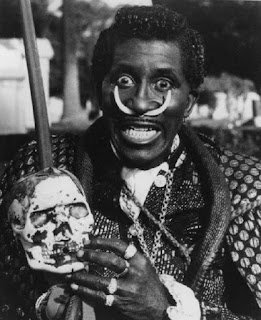I received the above Xmas card which contained the following greeting:
Have yourself a savage little Christmas
Make the Yuletide fierce ...
I liked it and put it under the tree. But my American friend, Winona, who is far more alert to the racial politics of art and language, said it was inherently offensive on multiple levels.
She explained how, for example, the image plays on white fear of the dark-skinned Other - portrayed here as an ape crazy gang member - and how the word savage is one that belongs to the lexicon of white supremacy and colonialism and is used to denigrate marginalised communities, dehumanise indigenous peoples, and justify genocide.
My (tentative) suggestion that perhaps the meaning of the word had changed over time and had now to be considered within a different cultural context [1], wasn't met with much sympathy or given a great deal of consideration.
Neither was the idea that perhaps it was just an amusing (if slightly disturbing) picture and that the sender of the card was simply referencing an album by Bow Wow Wow [2] and the popular Christmas song by Martin and Blane [3], without wishing to insult or upset anyone.
It doesn't matter what the intention of the sender is, she said, going on to argue that even those who perpetuate the myth of the noble savage and celebrate primitivism are still part of the problem [4].
All of which leaves me with a dilemma: do I leave the card up and fall back on a free speech defence; or do I take it down and concede that Winona's politically correct case is just that - i.e., right and proper.
I don't want to seem like an insensitive jerk flaunting their white privilege. But, on the other hand, nor do I want to become the kind of woke snowflake who self-censors in order to virtue signal. I suppose the liberal compromise would be to leave it up, but hide it behind the other cards with their anodyne angels and innocuous robins ...
Notes
[1] Savage - or sometimes savage as fuck (SAF) - has been used as online slang for some time now in order to characterise something as brutally honest, or ruthlessly hitting the nail on the head. It can also be used to indicate you find something extremely positive in a similar way that the term fierce is used within gay slang.
[2] The Bow Wow Wow album See Jungle! See Jungle! Go Join Your Gang Yeah! City All Over, Go Ape Crazy was released on RCA Records in October 1981. Click here to play the opening track 'See Jungle! (Jungle Boy)' and/or here to play ('I'm a) TV Savage' (both written by Matthew Ashman, David Barbarossa, Leigh Gorman, and Malcolm McLaren).
[3] The popular Christmas song 'Have Yourself a Merry Little Christmas' was written in 1943 by Hugh Martin and Ralph Blane and introduced by Judy Garland in the MGM musical Meet Me in St. Louis (dir. Vincente Minnelli, 1944). The lines parodied from the second verse originally read: 'Have yourself a merry little Christmas / Make the Yuletide gay'. Click here to play Sinatra's version from the album A Jolly Christmas from Frank Sinatra (Capitol Records, 1957 - remastered in 1999).
[4] Winona has asked me to cite the following work by Ter Ellingson; The Myth of the Noble Savage, (University of California press, 2001).
In this study, Ellingson - an associate professor of anthropology at the University of Washington - shows how the myth of the noble savage did not, in fact, originate with the 18th-century French philosopher Jean-Jacques Rousseau, and only really took hold as an idea when resurrected as a racist trope within mid-19th century British anthropology. See Amelia Hill's review of Ellingson's book in The Guardian (15 April 2001): click here.







